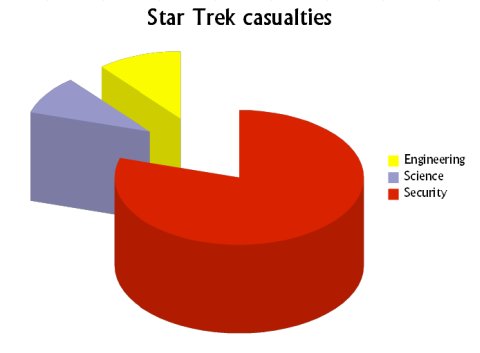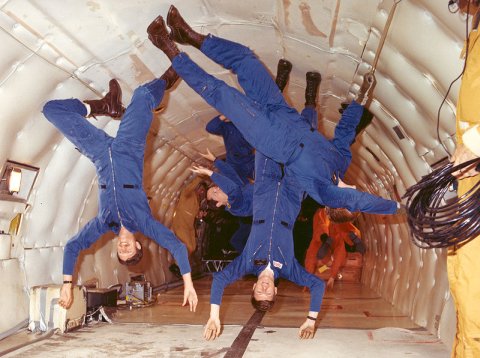Updated: April 22, 2011
O-la-la, here we go. You liked the first article, so here's a sequel! Today, we will discuss yet more cheesy, cliche and simply bad ideas, concepts and practices shown in the popular science fiction movies and TV series. Never again will you watch an episode of Star Trek or Dark Angel without the galactic wisdom of this article reverberating through your head. Let's rock.
Mistake 1: A foreign nationalist in the spaceship engineering

Usually, it's a Scotsman or an Irish, but sometimes you also get Russians. The important thing is that their English sounds weird and differently from the rest of the characters. Nothing like a quirky technician with a spanner and a cigarette stub to add spice to the plot.
I wonder why. Furthermore, Star Trek seemed so fixated that they replaced Scotty the Scotsman with Chief O'Brien, both saucily blessed with a northernly accent. The only mistake they did was not going for a Scouser in Deep Space Nine and a sheepshagging Welshman in Voyager. Ah, the little details.
Mistake 2: Local data center support

Note: Image taken from Wikipedia, licensed under GFDL 1.2.
On Earth, things work thusly: If you have a problem with hardware in your data center, you call in your local technicians. When they can't cope, you phone the 24/7 super-expensive second- and third-level support provided by hardware vendors, who then send their resident monkeys to fiddle with your blade centers and switches.
In sci-fi movies, aboard intergalatic ships, you will never find Dell or Cisco technicians enlisted as contingent workforce or highly paid consultants. All problems are always fully and completely solved by ship's crew, including the limitless supply of spare hard disks, SATA cables and power supplies. How wondrous. Yes, it does stand to logic that you will need lots of equipment brought along to manage an independent mission for months and years on end, but it seems reasonable to have a few specialists on your team, just in case.
Think about it. What happens if your data center cadet can't solve the problem. You phone home and they say, we're sending a recovery unit, they'll arrive in four years. Oh, beforehand, you wait seven hours for the radio communication to propagate through the vastness of space. Or better yet, you reach Eddie in India or Charlie in Costa Rica, who put you on hold for 50 minutes. And when you send a mail to corporate intergalatic hotline, the representative turns you down politely but firmly, insisting that your firmware version is out of date and that they do not support it any longer, do you mind answering a short questionnaire.
Mistake 3: Red shirt statistics

This is mainly related to Star Trek. For some weird reason, most of character deaths in both the original series and TNG were dressed in red uniforms. This became somewhat a matter of parody and later a serious business of research, spawning entire PhD thesis on color spectrum death probability density in the sci-fi genre.
More good reading:
Redshirt character on Wikipedia
Analytics According to Captain Kirk
Mistake 4: Intelligent robots

Note: This image is taken from deviantART, work of Retoucher07030, licensed under CC BY-NA-SA 3.0; based on Touchstone Pictures Marvin.
In the sci-fi genre, robots are almost humans, except they are better and smarter, wittier, far more eloquent, they don't whine about belly cramps and warts, they don't need sick leave or vacation days, they work all the time, and they have makeup that's superior to that of Adam Ant and Alice Cooper together.
Robots can be defined as any machine with a microchip and some physical motion ability, so in that regard, a car chassis welding tool is a robot of a sort. Now take a far-fetched leap into a Turing nightmare and you get androids and R2D2 and robots that do pretty much everything, including emotions. Even Arnold's red-eyed titanium-skeleton killing machine pulls a teary-eye stunt at the end of Terminator II when it decides to suicide itself for the sake of a snotty brat slash prophetic leader of the post-apocalyptic humanity.
In reality, we probably won't see an independent, intelligent robot before 2050, at least not one with the ability to sustain its survival without external inputs. And even then, it will come down to a floating point precision paradox, which will always defeat the wisest of robots with simple deterministic bugs. Speaking of 2050, the little robot will have all the smarts of a cockroach and just about as much ability to operate an iPhone.
Mistake 5: Artificial gravity

Very few movies or series portray the delicate matter of weightlessness in space accurately. It's a tricky deal. In the absence of gravity, you lose weight, you lose strength, you lose bone marrow, there are all kinds of problems with your immune system and your digestion. Rather than fight it, they just ignore it.
The problem is solved by magicking gravity onto ships, without making them into fast-rotating cylinders. Laws of physics are daintily sidetracked for the sake of populism. Being able to pee has never been so easy, without ever worrying about your own urinal stream coming back to haunt you.
Mistake 6: Force fields

Force fields are supposed to be magic Kevlar vests unto spaceships. In theory, they sound like a nice concept, until you take into account the massive electromagnetic interference created, which would probably disrupt electronics and communication and cause early cancer in just about everyone. Furthermore, force fields would not really work against non-electromagnetic weapons, like kinetic projectiles. A good example is our own planet, which has its cloak of protection against space particles in the form of the magnetic field. But even the combined effect of a thick atmosphere and the magnetic field can't keep all the radiation away and certainly not stop the bigger and heavier meteors. The same applies to spaceships.
However, even if we assume that you might build a multi-layered force field that would interact with gravitons and electroweak particles, too, imagine the amount of energy required to sustain such a shield in place. What more, it needs to be several orders more powerful than any enemy weapon.
While enemies can focus their energy blast to a very narrow spot, creating a high-density charge, a defender must deploy a large shield that protects vital ship areas. Furthermore, the shield has to be placed some distance from the hull and maintained in a very narrow band of space. Without any other consideration, the force field has to be more powerful than the attacking weapon by at least a power of two, because of spatial considerations. If we take into account the ship's size and the distance of the shield from the ship, it becomes even worse.
The simplest comparison is a modern tank armor versus a high-speed Sabot projectile; a tank needs 50-60 tons of expensive, composite armor of steel, depleted uranium and ceramics to protect against a 5-kg bullet.
In one word, dreck.
Mistake 7: Sick bays

Note: Image take from Wikipedia, licensed under GFDL 1.2.
Sci-fi movies and series almost universally depict a bright and technologically advanced society blessed with instant medicine. Just pop into a sick bay, get scanned with a tiny Geiger-like thingie that bleeps and whirs and makes plinking noises and you're healed. Never mind the fact that common diseases no longer exist in the future. Even non-trivial problems like cancer and suchlike are cured in seconds. Shattered ribs, amputated limbs? No worries. The sick bay scanner is going to fix it for you. Better than a faith healer.
So my question is ... if medicine has become as trivial as brushing your teeth, why do you need large, expensive sick bays? Why does every sci-fi movie and series have hospital-grade infirmaries, where the only tool ever used to mend broken patients is the magic healer wand?
Mistake 8: Annoying kids

Note: Image taken from deviantART, courtesy of Whynne.
Most of the movies and series have an annoying brat polluting the atmosphere with his/her smarmy attitude and scripted smarts. Look, it's a kid, and he has an answer that people twenty or thirty years his senior, educated at the finest universities, can't find. Forget partial differential equations and Casimir Effect, the unruly and spoiled child will fix it with duct tape and inspiration from that episode of Teletubbies.
I understand the would-be attempt to make younger audience feel more engaged. But it makes no sense to keep stupid and underdeveloped offspring lurking about in space warships or in remote outposts on forbidding planets infested with strange aliens and unknown perils.
Oh, the most annoying kid ever portrayed in a movie was the snot in The Day the Earth Stood Still. Even more annoying than the dog-stabber fork child in The Signs. Makes you wish the Earth lost.
Mistake 9: There's always a nuclear holocaust

Nuclear holocaust, a massive outbreak of some deadly virus, the atmosphere going kaput. The futuristic Earth is always brought to a standstill somehow. From Mad Max via Highlander via Twelve Monkeys all the way to Star Trek, our planet undergoes a human-made massive extinction, usually accompanied with lots of kaboom and neutron radiation. But why?
The last biggie was the Plague in the fourteenth century, but back then, people thought feces were good for your health, and even so, only about 70% of population died. Before that, there were magnetic pole reversals, solar flares and an odd meteor or two, but they happened millions of years ago. So why should there be any special cataclysmic event in say, a hundred or even three hundred years from now?
Mistake 10: There are no toilets in space

Assuming you've overcome the perils of gravity, you still need to go occasionally for number one and number two. And yet, there are no toilets in the future. Spaceships are poop-free zones, aliens have magical nappies that filtrate their urine better than those special suites in Dune.
Where did all toilets go? Don't our heroes need to relax now and then, have a read? Doesn't Picard get a clenching moment now and then? Wasn't Snake Plissken afraid when he EMP-ed the world?
Now, let's consider the actual sewage capacity of a modern spaceship. Take a 1,000-crew ship, with equal half-male half-female population. Using today's world eating and hygiene statistics, we're talking five to six urinal trips and an average one Zen-like moment per crewmember a day, resulting in about two liters of fluid and 400-gr turding. With no special bacteria to bio-degrade the waste, we're amassing 400 kg of browncake and two tons of lemonjuice every single day. This translates into 700 hundred tons of peepee and 150 tons of cacky a year, and this is a conservative estimate. Where do you put all that? Or do you just eject all that into space?
Imagine, bio-warfare between rival ships. As they swoop past another, you get them showered with your waste. And if they don't have any window wipers, they end up with polluted starscape until the next visit in an orbital maintenance shop.
Better yet, since the vacuum is fairly cold, ejected feces turn into solid ice instantly. So with some knowledge of ballistics and good timing, you can use human excrements as kinetic weapons. If you fire them from your ship when moving at great speed, you can create a meteor shower of unprecedented physical and psychological impact. You can even use the gravitational pull of nearby stars and planets to make your dung accelerate, becoming even deadlier. Theoretically, you can have a 1,000-ton kinetic projectile created from inedible parts of human diet, available for launching at 20 km/sec, at your disposal. Farts have never been more dangerous.
And so the space weapons become pissiles and turdpedoes. Oh man, what a moment of poetic brilliance. Now, this is what I call - biological warfare! Yeah! I win!
Conclusion
That's it, another supreme list compiled. After overrated movies and the first part, this comes as the new crown jewel of poetic justice, wielded in the hands of Dedoimedo. Science fiction is a lovely genre, but some things are just not meant to be. I'm especially proud of the fecal weapons in the last point raised. That was a stroke of brilliance. But all other mistakes are valid annoyances that movie producers try to slip under the radar, unnoticed. Unfortunately for them, I've got the eye of the tiger and nothing gets past. The laws of physics must be obeyed.
I hope you liked this. There might yet be a third part, but it depends on YOU. Send me your ideas, the things that bother you from the scientific and technological perspective, and they might feature in the next article. That would be all. Have fun science-fictioning.
P.S. The mechanic, the Vomit Comet, the magnetic field trail, and the nuclear blast are in public domain.
Cheers.